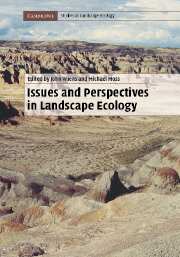Book contents
- Frontmatter
- Contents
- List of contributors
- Preface
- PART I Introductory perspectives
- PART II Theory, experiments, and models in landscape ecology
- 3 Theory in landscape ecology
- 4 Hierarchy theory and the landscape … level? or, Words do matter
- 5 Equilibrium versus non-equilibrium landscapes
- 6 Disturbances and landscapes: the little things count
- 7 Scale and an organism-centric focus for studying interspecific interactions in landscapes
- 8 The role of experiments in landscape ecology
- 9 Spatial modeling in landscape ecology
- 10 The promise of landscape modeling: successes, failures, and evolution
- PART III Landscape patterns
- PART IV Landscape dynamics on multiple scales
- PART V Applications of landscape ecology
- PART VI Cultural perspectives and landscape planning
- PART VII Retrospect and prospect
- Index
- Plate section
- References
10 - The promise of landscape modeling: successes, failures, and evolution
from PART II - Theory, experiments, and models in landscape ecology
Published online by Cambridge University Press: 20 November 2009
- Frontmatter
- Contents
- List of contributors
- Preface
- PART I Introductory perspectives
- PART II Theory, experiments, and models in landscape ecology
- 3 Theory in landscape ecology
- 4 Hierarchy theory and the landscape … level? or, Words do matter
- 5 Equilibrium versus non-equilibrium landscapes
- 6 Disturbances and landscapes: the little things count
- 7 Scale and an organism-centric focus for studying interspecific interactions in landscapes
- 8 The role of experiments in landscape ecology
- 9 Spatial modeling in landscape ecology
- 10 The promise of landscape modeling: successes, failures, and evolution
- PART III Landscape patterns
- PART IV Landscape dynamics on multiple scales
- PART V Applications of landscape ecology
- PART VI Cultural perspectives and landscape planning
- PART VII Retrospect and prospect
- Index
- Plate section
- References
Summary
In 1990, Fred Sklar and Robert Costanza began their review of spatial models in landscape ecology with this statement:
We are at the dawn of a new era in the mathematical modeling of ecological systems. The advent of supercomputers and parallel processing, together with the ready accessibility of time series of remote sensing images, have combined with the maturing of ecology to allow us to finally begin to realize some of the early promise of the mathematical modeling of ecosystems. The key is the incorporation of space as well as time into the models at levels of resolution that are meaningful to the myriad ecosystem management problems we now face. This explicitly spatial aspect is what motivates landscape ecology.
They went on to describe a host of environmental and global issues that, because of their complexity, require spatial analysis and modeling to solve. While their introduction suggests the beginning of Star Trek, a popular television and movie series on another type of space exploration, there was a great deal of truth in what they said. The timing of their statement was also prescient. It is now over a decade since Sklar and Costanza and several other papers reviewed the status of landscape change models. Baker (1989) also laid out a useful framework for classifying and thinking about different landscape modeling approaches.
- Type
- Chapter
- Information
- Issues and Perspectives in Landscape Ecology , pp. 90 - 100Publisher: Cambridge University PressPrint publication year: 2005
References
- 5
- Cited by

